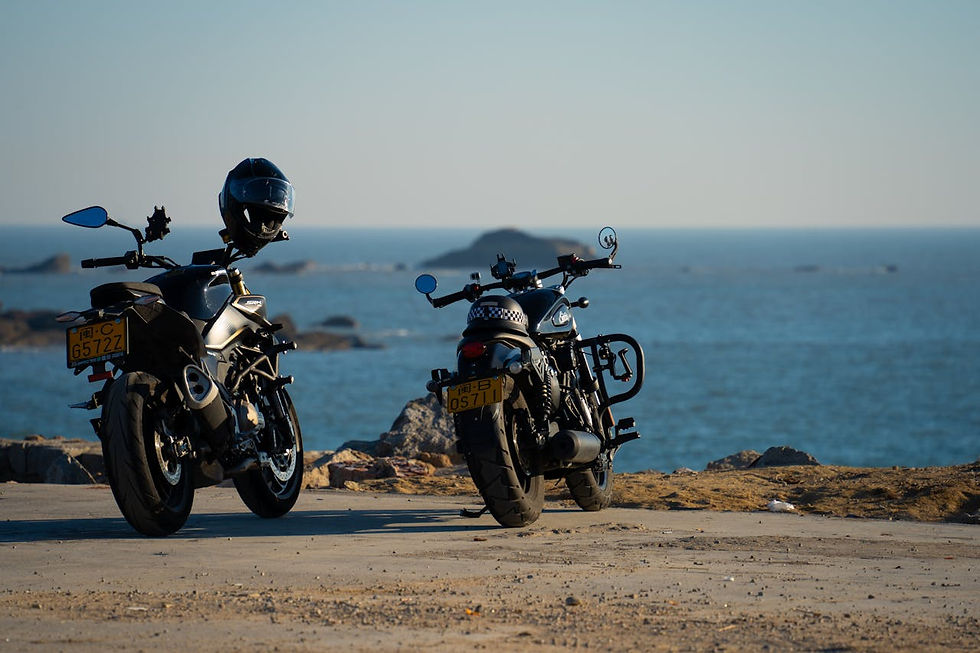What and When to Use Engine Braking?
- Animesh Roy
- Feb 8, 2024
- 3 min read

Engine braking is a technique that every motorcycle rider should understand and utilize effectively. It's not just about slowing down your bike, it's about maximizing control, enhancing safety, and prolonging the lifespan of your motorcycle's components. In this comprehensive guide, we'll delve into the intricacies of engine braking, exploring what it is, how it works, and when to use it for optimal performance on the road.
What is Engine Braking?
Engine braking, also known as compression braking, is a method of decelerating a motorcycle by downshifting gears and utilizing the engine's resistance to slow down the bike. Unlike traditional braking systems that rely solely on the brake pads and rotors to reduce speed, engine braking harnesses the mechanical resistance generated within the engine itself.
How Engine Braking Works:
When you roll off the throttle or close the throttle grip, the fuel supply to the engine is cut off, resulting in a decrease in power output. As a result, the engine's compression stroke creates resistance against the turning crankshaft, which in turn slows down the motorcycle. This phenomenon is particularly pronounced in engines with higher compression ratios and in lower gears.
Benefits of Engine Braking:
Enhanced Control: Engine braking allows for smoother deceleration, enabling riders to maintain better control over their motorcycles, especially in challenging road conditions or during abrupt stops.
Reduced Brake Wear: By relying on engine braking to slow down, riders can minimize wear and tear on their brake pads and rotors, ultimately extending the lifespan of these critical components.
Improved Safety: Engine braking can be a lifesaver in emergency situations where conventional braking alone may not be sufficient to avoid a collision. It provides an additional layer of braking force that can help prevent accidents.
Downhill Descents: When navigating steep downhill slopes, engine braking can help maintain a steady speed without relying excessively on the brakes, thus preventing brake fade and overheating.
Smooth Transitions: By downshifting and utilizing engine braking during gear changes, riders can achieve smoother transitions between speeds, enhancing overall riding comfort and stability.
When to Use Engine Braking:
Approaching Turns: Engine braking is particularly effective when entering a corner or a bend in the road. By downshifting and utilizing engine braking, riders can slow down smoothly while maintaining optimal control and stability through the turn.
Downshifting: When decelerating or coming to a stop, downshifting gears and engaging engine braking can help modulate speed more effectively, especially in situations where sudden stops are required.
Descending Hills: When riding downhill, using engine braking in conjunction with traditional braking techniques can help regulate speed and prevent brake fade, ensuring a safer descent.
Preserving Brakes: To reduce wear and tear on brake components, riders can rely on engine braking as a primary means of slowing down, particularly during routine commuting or long-distance rides.
Emergency Situations: In emergencies where immediate stopping power is needed, such as avoiding obstacles or sudden hazards, engine braking can provide an additional layer of braking force to complement traditional braking systems.
Mastering engine braking is an essential skill for every motorcycle rider, offering numerous benefits in terms of control, safety, and mechanical longevity. By understanding how engine braking works and knowing when to use it effectively, riders can enhance their riding experience and stay safer on the road. Whether navigating winding mountain roads or negotiating urban traffic, incorporating engine braking into your riding technique can make you a more skilled and confident motorcyclist. So, next time you hit the road, remember to harness the power of your engine for smoother, safer rides.
Ride Hard, Ride Safe!


